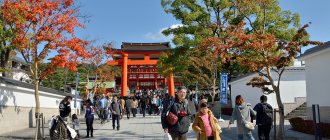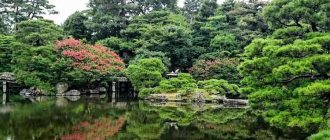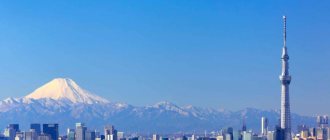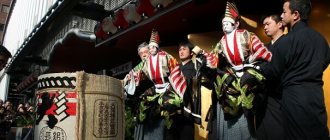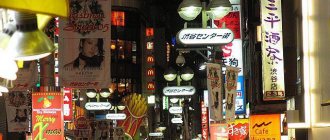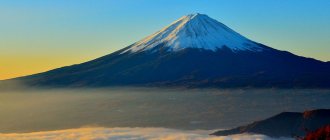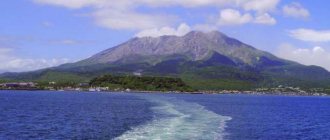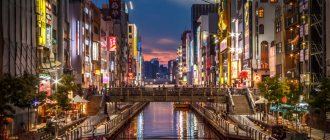Nagano is a city in Japan that gained worldwide fame in 1998 when the Olympic Games were held here.
Largely thanks to this event, the city received a modern tourism infrastructure, which allows today to receive solid profits from travelers from different countries. People come to Nagano primarily because of the abundance of attractions and gorgeous nature. Just look at the local mountain landscapes, photographs of which are available in large quantities on the World Wide Web. In addition, unlike Tokyo, Nagano is a fairly calm city with a modest number of permanent residents (just under 400 thousand people). Here you can relax and escape from the bustle of big cities.
Below is information about the main attractions of Nagano, which every tourist who comes here should visit. It's no secret that many tourists also dream of visiting the city of Paris. If you want to get to know the sights of this European city better, we recommend visiting the website www.parislife.info.
Interesting Facts
It is located on the island of Honshu. It must be said that the city acquired its modern name in 1871. After the abolition of internecine disagreements among small feudal lords. And its borders were finally established in 1876, and remain unchanged to this day.
The city is famous for its agricultural sector: the cultivation of apples, peaches and even grapes has also made Nagano famous. Magnificent large, juicy and tasty apples are very popular throughout Japan. A little more actively, from century to century, rice farming also flourished here. The industrial sector also helps develop the region's economy.
In 1998, Nagano was chosen as the capital of the Olympic Games. Thus, the XVIII Winter Olympic Games were held closest to the equator, in comparison with the past ones (let me remind you that the “summer” ones were held in 1964 in Tokyo, and the “winter” ones in 1972 in Sapporo, Japan) . This event glorified the city and attracted a new flow of tourists to Japan.
Matsushiro Castle
Matsushiro - fortress of the 15th-16th centuries. In the past, this castle was surrounded by a city that grew around its walls. During the Meiji period (19th century) it was ordered to be destroyed. Therefore, only the remains of a stone fence have reached us. However, the wooden bridge, the fortress moat and the gate were nevertheless restored. More than 100 sakura trees are planted around the castle, which you can admire both day and night.
Features of tourism
Historically, Nagano is a religious center. Buddhist movements left a legacy of a great many temple complexes and architectural monuments. From year to year, the doors are open here for millions of monks and pilgrims from all over the world. They all dream of seeing the very first image of Buddha located in the Zenkoji Temple.
If we consider the interests of tourists, the following places are the most interesting in this regard:
- In Nagano there is a park of world-famous “snow monkeys” (photo above). The reserve is located in the mountains, and more than 150 Japanese monkeys live on its territory. Here you can see how, in a fairly cold climate, animals take baths in hot thermal springs.
An interesting sight - funny animals with the whole family warming themselves in a hot pond :-). Here you will not find any special fences, and animals can be seen at a distance of a meter. Although monkeys are accustomed to the presence of people, I would not recommend getting too close to them or feeding them from the palm of your hand.
- Not far from Nagano, in the city of Matsumoto, there is the famous, oldest castle of the same name (松本城・まつもとじょう)! Due to its black color and open slopes of the roofs, it is also called Karasujo: (“jo” is the castle), which translated means “Castle of the Black Raven.” Many rightfully consider it the most beautiful castle in Japan. Karasudze is washed by water on three sides, the walls are impregnable - it is a majestic citadel located on a specially constructed stone hill, rising on the surface of the water.
The spectacle is truly impressive; you immediately immerse yourself in this ancient atmosphere, imbued with the spirit of the samurai. And in the spring you can watch sakura growing in his gardens.
- At the foot of the northern Alps (I talked about this in this article), there is the area of Azumino, famous for its rice plantations. Here, at the Rice Museum, you will be offered to drink craft rice sake. Azumino is a paradise for ski lovers, because there are quite a few ski resorts and skating rinks here.
- For adventure lovers, Nagano Prefecture has prepared wonderful hiking trips to the sacred village of Togakushi. Where everyone can try themselves as a ninja! After all, Togakushi is a Ninja village shrouded in secrets and romantic mythology.
- Kamikochi Nature Reserve is a beautiful mountainous area, with picturesque views of white cliffs and rushing rivers. This park opens its doors to everyone from April to November. Hiking and mountain tourism are well developed here, and cozy recreation centers are located in the river valley. To fully enjoy your vacation in Kamikochi, you should stay here for 3-4 days.
- There are famous thermal springs here and there throughout the prefecture. Water heated by magmatic steam has beneficial properties: saturated with valuable minerals, it “renews” the body and improves the quality of the skin, making it smoother.
Matsumoto Castle
Because of its black color and roofs shaped like the wings of a flying bird, Matsumoto's five-story castle was nicknamed the "Raven Castle." This majestic ancient building was built in the 16th century. One of its sides was specifically designed for observing the moon. The castle was erected by one of the samurai clans of that time as a fortification.
Climate Features
In the prefecture you will not find white beaches, endless seas and hot tropical heat. Summers here are cool, and in winter there is a large amount of snow. Therefore, the tourist peak falls precisely in winter.
Thousands of winter sports enthusiasts come to spend weekends or holidays in the mountainous regions of Japan. They spend time at comfortable ski resorts and admire all the splendor of nature.
If we talk about the average temperature in the region, then in winter, the temperature rarely drops below -4-6 degrees Celsius, while in summer it rarely rises above 25-27 degrees. It seems to me that the climate here is really mild and pleasant. In summer, the prefecture experiences a rainy season, while in winter there is heavy snowfall.
Nagano
Search for a tour to Japan
Nagano Prefecture, the capital of the 1998 Olympic Games, remains popular among winter sports enthusiasts in Japan. From December to March in Nagano you can watch the World Cup stages in biathlon, cross-country skiing, freestyle skiing, and moreover, everyone can independently try their hand at skiing. This area of Honshu Island is the most mountainous, which is why locals often call it the “roof of Japan.” At this place the Japanese, Southern, Central and Northern Alps converge - the ridges of the Kiso, Akaishi, Hotaka, Yari mountains, rising more than 2500 meters. The Nagano Mountains were called the Japanese Alps by the British mining engineer William Gowland in the 19th century, and over time it became commonly used. In addition, it is worth noting the fact that many small rivers flow between them, making the already amazing nature even more picturesque. As a result of the significant distance from the sea and the abundance of mountains, the climate here is much drier and colder than the surrounding prefectures. In winter there is a large amount of precipitation in the form of snow, in summer it is quite cool.
The population of the prefecture is about two million people, and its area is approximately 13,600 square meters. km. The territory of today's Nagano Prefecture, which became known as Shinano Province after political reforms in 645, was located at the crossroads of Eastern and Western Japan. This province was under the rule of feudal warlords who competed with each other, the Takeda and Uesugi, and during their period of power (the Edo period) it was divided into small possessions. Only in 1871 did the prefecture receive its modern name, and its borders were precisely defined in 1876.
The main direction of agriculture in Nagano is rice growing. The prefecture produces peaches, grapes and apples, famous throughout the Land of the Rising Sun. In addition, there are numerous dairy farms. Silk production flourished in Nagano before the outbreak of World War II. Today, the most rapidly developing industries are metal production, wood products, electronics, precision engineering, and food manufacturing.
The administrative center of Nagano Prefecture is the city of Nagano. It is located approximately 250 kilometers northwest of Tokyo. Using the Hokuriku Shinkansen, a high-speed railway line, Nagano is connected to the capital of the Land of the Rising Sun. The opening of this line occurred in 1997. Since then, it has provided everyone with the opportunity to travel to Tokyo in just an hour and a half.
A huge number of tourists in Nagano are attracted, first of all, by the many hot springs, lakes and mountains. On the territory of the prefecture there are several parts of four natural national parks - Chubu Sangaku, Chichibu-Tama, Minami Arupusu, Joshin'etsu Kogen.
Among the prefecture's attractions are the many Olympic structures created for the 1998 Winter Olympics held in Nagano. Its implementation helped solve many transport problems. Today, Nagano can be reached by high-speed train. In addition, everyone who has been there claims that every tourist who comes there simply must see Zenkoji Temple. According to legend, it was founded in the 7th century. The main structure of this ancient temple, considered a magnificent example of Edo period architecture, was completed in the 18th century. The glory of this temple is so great in the Land of the Rising Sun that all the believers who visited Nagano constantly attempted to create something similar in their homeland. Scholars count approximately 240 branches of the temple, which are called Shin-Zenkoji, as well as 410 copies of the Buddhist Triad, made of bronze, which are worshiped in various parts of Japan. Naturally, it is impossible to calculate how many such copies are in home altars. This can be explained by the fact that many believers want to receive a guarantee of heavenly existence during their lifetime. According to a long-standing legend, the image of the Triad has the ability to bring relief to the sick. It guarantees the person who came to worship the deity eternal life in paradise. Once every six years, the monks open access to believers to see the Triad. This ceremony is called Gokaicho, which translates as the opening of the shrine. It is worth noting the fact that in fact, it is not the original holy sculptures that are put on display for worship or viewing, but only their copies. But, in spite of everything, it is believed that this is quite enough for believers to become enlightened. All tourists and travelers who want to go there must come to Nagano during Go-kaicho. Not far from the city are the Kawanakajima battlefields. They are famous for being the site of five bloody battles between the rival Uesugi and Takeda clans. The sculpture, which depicts a duel between two samurai - clan leaders, was installed here in memory of these historical events.
In the heart of the prefecture is the city of Matsumoto, which is the gateway to the natural national park called Chubu Sangaku. It is here that the feudal castle is located, which is the best preserved to this day. Matsumoto Castle was created in the 16th century - it is a unique five-tiered structure. Due to its shape and color, it received the nickname Raven from local residents and is currently considered a national treasure. Since ancient times, Matsumoto has been famous for its craftsmen working with mahogany. The mountains around the city abound in timber. In addition, due to the fact that this area is the most mountainous in the Land of the Rising Sun, the local climate creates excellent conditions for storing and drying various types of wood. Local residents claim that furniture production in this city began around the end of the 16th century. In those days, the most popular cabinets were those created in the form of a secretary or chest of drawers with a huge number of drawers, inside which merchants could store various financial documents. A distinctive feature of this furniture is its assembly. Almost every part of it fits without a single nail or screw. In addition, hidden bamboo wedges are driven into the corner joints, which perfectly hold several pieces of wood. It is widely believed that Japanese cabinetmakers were so inventive in creating their masterpieces that it was common for a single chest of drawers to have as many as fifty different types of joints that were so strong that they could not be pulled apart.
Another place that is quite popular among tourists and travelers is Azumino, a vast area located at the very foot of the Japanese Northern Alps. Visitors are attracted to the world-famous sake museum here, which also showcases the approximately one hundred varieties of rice wine produced in the area.
The next place that everyone who comes to Nagano must visit is Kamikochi. Kamikochi is one of the most picturesque areas in the Land of the Rising Sun. It is a narrow plain located at an altitude of 1600 meters above sea level. This is where climbers from all over the world begin preparing for the ascent. In summer it is very picturesque and cool here. Nearby is an amazingly beautiful lake - Taisho, formed after the 1915 eruption of the Yakedake volcano, the lava of which blocked the Azusa River. In addition, there is Kappa, a suspension bridge, upon climbing which you can see a stunning view of the huge Mount Hotaka. The large volcanic zone provided a huge amount of hot, life-giving springs to the prefecture.
In winter, when the mountains are covered with a thick layer of snow, Nagano is called a real Mecca for all people who love winter sports. This place is home to about 45 skating rinks and 110 ski lodges, which are visited by more than 22 million people per year. The winter snowy and rather cold climate, which constantly complicates the life of the population in this mountainous region, is a valuable source of income received from tourism; in addition, we should not forget that no one will be indifferent to the local cuisine.
How to get there
Nagano is located almost 200 km from the capital, Tokyo. The two cities are connected by a high-speed rail line (Nagano Shinkansen). Thus, the travel time will not exceed two hours.
As for other cities, for example, getting there from Osaka is also not difficult - all the same lines, high-speed railways, by plane or by car. However, the travel time from Osaka is almost twice as long as the trip from Tokyo. It’s worth taking this into account when planning your tour of the Land of the Rising Sun.
Mountainous terrain with turbulent river flows, calm picturesque valleys and the magnificent Matsumoto Castle attract tourists to Nagano Prefecture year after year. Famous throughout the world for its natural reserves and stunning historical and religious sites, the city has become a favorite place for winter sports supporters.
I hope the article turned out to be interesting and useful in planning your trip. Subscribe to my blog and recommend it to your friends. See you soon, dear readers!
Lika Raido
